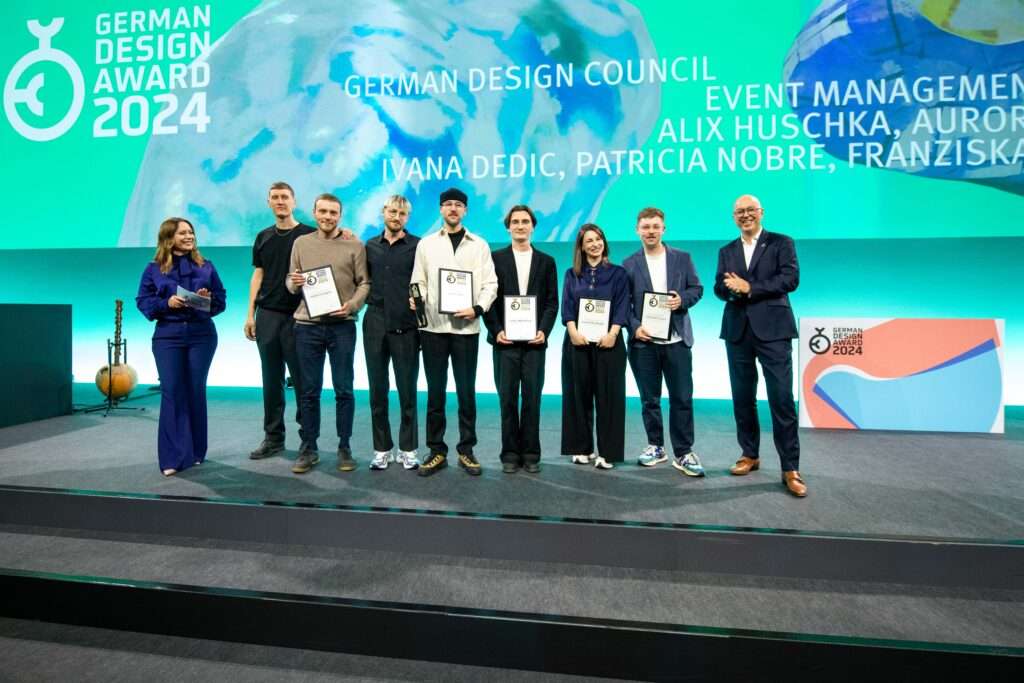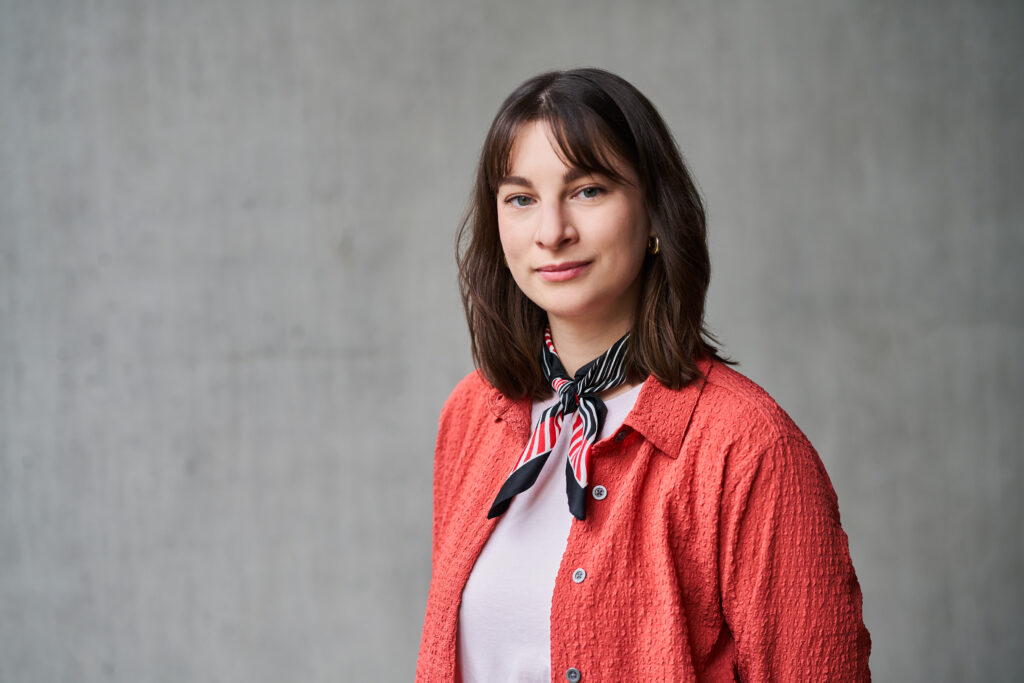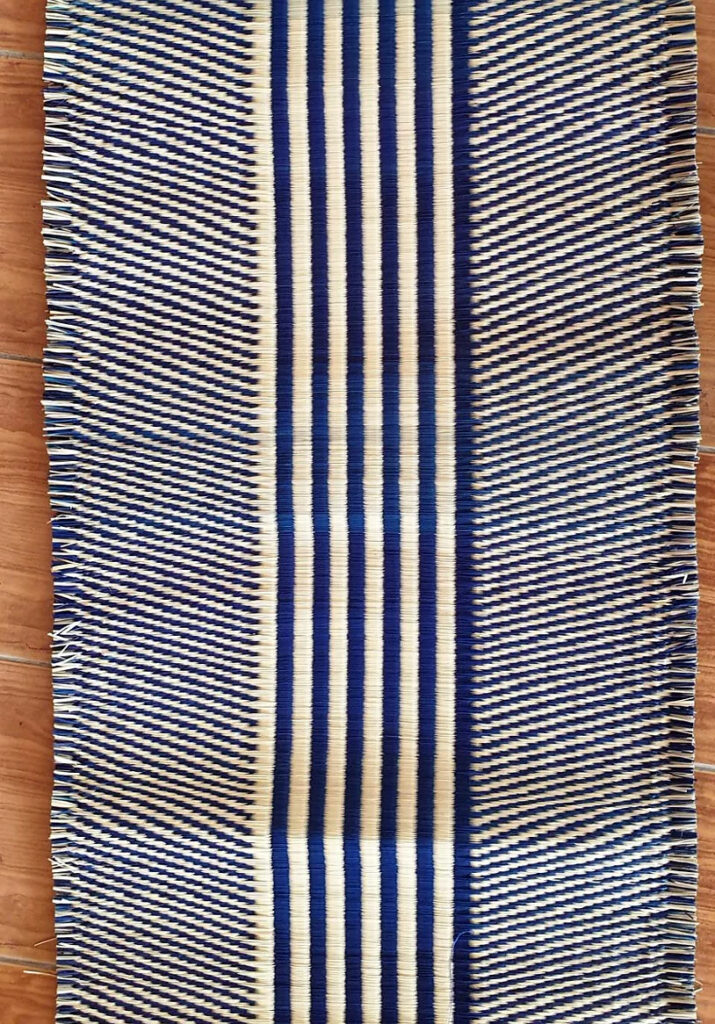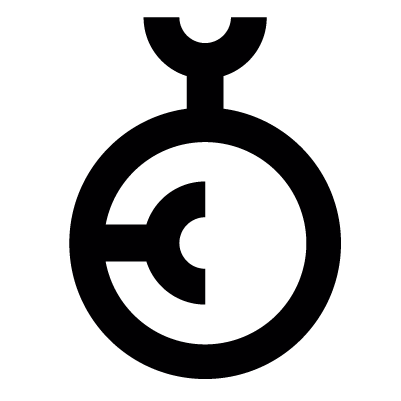Eva Marguerre, Marcel Besau, Sebastian Herkner and Christian Zanzotti have all been honoured as “German Design Awards Newcomers” in the past. The German Design Council’s Newcomer Awards has often acted as a catalyst for further careers. On 26 January, another Newcomer of the Year will be chosen. The current finalists introduce themselves here.
Interviews by Rebecca Espenschied

Five newcomer designers have made it through to the final round this time. The “Newcomer of the Year” will be announced at the German Design Awards 2024 ceremony on 26 January. The five finalists for the award – Leonie Burkhardt, Justus Hilfenhaus, Nicolas König, studio formagora (Finn Blankenberg, Esra Heuermann, Nick Potter) and Sebastian Winter – give insights into their work in an interview, tell us what has shaped them and what paths they are taking in design.
Newcomer Leonie Burkhardt answers the question of how she manages to mediate between tradition and innovation, combining the conflicting fields of craftsmanship, art and design:
In my eyes, traditional craftsmanship is the foundation for further developing and rethinking a technique or material. In recent years, I have worked a lot on Jacquard weaving machines – industrial machines that are programmed using web software. It all looks very complicated at first, but ultimately everything is based on the same principle that was used centuries ago: the right-angled interlacing of two thread systems. In my master’s project “Woven Forms”, I was concerned with the question: How can you create three-dimensionality on a device that is only intended to create something two-dimensional? I see this process as experimental design research, the end product of which does not necessarily have to fulfil a specific “function”. This blurs the boundaries between design, craft and art. In my opinion, there is not necessarily a need to separate these fields.

You studied at various international universities. What experiences were influential for your work?
During my bachelor’s degree in Hamburg, I decided to spend a semester abroad in Bangkok, Thailand. On the one hand, I gained a broader understanding of my field during this time, as Southeast Asia is rich in textile history and culture. On the other hand, my focus was to actively experience a non-European view of design and to exchange ideas about design and craftsmanship with another culture. For my Master’s programme, I chose a university that combines practice and theory in design. At the Swedish School of Textiles in Borås, there are workshops that make the hearts of textile enthusiasts beat faster. There is also a strong focus on the theory of design. The combination of making and thinking, or thinking in making and thinking about making, had a strong influence on me and made me a better designer.

Collection of three-dimensional woven abstract shapes: Material and shape research on active yarns and multilayer weaving, Photo: Daniela Ferro
What issues are you currently dealing with?
I am currently working with a local knitting company. We are developing different ideas on how to take three-dimensional thinking further in knitwear and utilise the qualities of knitwear in the subject matter. I would also like to continue my research into 3D weaving and bring together the fields of textiles and architecture. I see potential in thinking bigger about fabric. That’s why I’m even happier to be nominated for the German Design Awards and to meet people from different disciplines.

33D woven blocks that come flat from the loom and become three-dimensional Building Blocks by certain cutting and filling with textile waste. Project in co-operation with Jojo Shone. Photo: Patty van den Elshout i.o.v. TextielMuseum

Woven mat made from dyed and undyed reed, which is a leftover material from Thai agriculture. © Leonie Burkhardt
Newcomer Justus Hilfenhaus, who is familiar with various product worlds and develops lights, electrical appliances and furniture with great precision, answers the question of how he manages to design products that go beyond the usual added value:

For me, the usual added value describes the obvious function of a product. I try to give every object I design a benefit that goes beyond this usual added value. For me, this is not always about an additional or greatly improved function. In my work, added value is also created through symbolic character or emotional connection. For example, a shelf becomes more than just storage space, a self-charging kitchen radio becomes a symbol for saving energy and a side table becomes a helper for older people.
Your products should be tangible: How do you manage to connect product and user in your work through analogue interaction?
I think that the moment of fascination is the beginning of this connection. You might see something that you don’t fully understand or haven’t seen before and become curious. By designing intriguing, possibly visually unusual details, I try to invite viewers to engage with the objects. This interaction then reveals the special nature of the design. This specially acquired realisation is intended to create a certain kind of pride of ownership among users and establish an emotional connection to the product.

Are there any product designers who inspire you? If so, can you describe which works particularly fascinate you?
I am very inspired by the work of Kim Collin and Sam Hecht (Industrial Facility). I find it fascinating how in many of their designs the intuition of using a product is thought through to the smallest detail. Redefining problems and then solving them in a very simple and aesthetically pleasing, timeless way really appeals to me. I think this simplicity makes Industrial Facility’s products very accessible and extremely easy to understand. They are clever solutions that seem self-evident thanks to good design.

MMore than just one shelf. Two becomes three. Three becomes five. © Tamara Knapp
With his research-orientated work, he pursues the goal of creating structures in the built environment that relate to and harmonise with the natural environment. Newcomer Nicolas König explains how he finds answers to questions about the future of our planet in the design of living spaces:
I am currently working intensively on the potential of solar radiation in our built environment, for example the solar grill project. The solar grill is an experimental instrument for sun-powered cooking that questions current consumption and cooking habits that rely on constantly available energy sources and are independent of natural rhythms. Many of my projects deal with hybrid future stories – with the synergy of nature and technology. I believe that we should carefully utilise the potential of our environment instead of fighting against nature or exploiting it irreversibly.

Fictional scenarios can be found in your portfolio as well as very pragmatic projects. What is the decisive factor for you when approaching certain topics?
Driven by the sheer abundance of information available to us today, my projects sometimes take detours through fictional narratives. It’s about constantly developing new languages that can clarify, formulate, and visualise the initially vague core statement of an investigation. This sometimes works better through fragmentary models, images, or plans; in the end, these elements then grow together. The process requires humour, courage, hope, and a kind of creative innocence. The idea lies somewhere between purposeful chaos and orderly calm.

You spent a semester abroad at the Royal Academy of Fine Arts in Copenhagen. To what extent was this defining for your work?
In Scandinavia, they know that creative thinking requires a balanced life. At the same time, they have a fascinating understanding of collaborative work, which has had a huge impact on me: I believe in the fruitfulness of creating and thinking together. The majority of my projects are collaborative.

For the newcomer trio of Finn Blankenberg, Esra Heuermann and Nick Potter, who together form the “studio formagora”, empowerment and cooperation are at the forefront. So how do they utilise their different strengths in their collaboration?
We have different personalities, different interests, creative approaches, motivations, and goals. It can sometimes be difficult to reconcile them. It is important to us that everyone can develop further in the collaboration. We try to find room for this in the design process and always work according to the consensus principle when making decisions. In this way, we discuss and develop high-quality results from this diversity.


You want to promote socio-ecological change. What does responsible design mean to you and what criteria do you apply?
We can see from geopolitical changes, the climate catastrophe, protest movements, and much more that it is not enough to simply design the product. We have to pay attention to supply chains, environmental impacts, production conditions, energy consumption, distributive justice, and much more. As designers, we often have a better overview of this than many others. We therefore see it as our responsibility, but also our opportunity, to intervene in the entire process in a creative way. We cannot do this alone, but perhaps as moderators of multi-professional teams. What is very important to us is that we want to design for people and their needs. Not for a growth logic that has reached the planetary upper and lower limits for decades.
Public space, encounters and crafts are core elements of your work. How do you define and implement participatory design processes?
Genuine participation requires us as designers to relinquish our sole decision-making power, our exclusive right, and instead establish a democratic process. However, for this to really make sense and create added value, everyone involved must be empowered to make informed decisions. This requires continuity, time and resources. The design benefits massively from the knowledge of local people and iteration. So we must not make the mistake of thinking that participation is done with an informative event. It is a lengthy, complex process that always requires an openness to results. But the special thing about it is that a participatory design process can be a social process – encounters or even friendships are created. People are also empowered to play an active role in shaping their own environment. And often this is still a privilege: language, time, capacity or knowledge can be barriers to being able to take part in public participation processes.
Newcomer Sebastian Winter is involved in communication design and digital design. Using creative coding, he aims to promote interaction and open up dialogue in order to make complex content, particularly in the fields of education and science, as accessible as possible. He explains the basics of his work as an interaction designer:
Three basic principles or theses come to mind: communication design should not be static, but should react to users. Relevant content is essential – collaborations in education and science are a good source for this. Constantly learning new things and passing on your own knowledge – this keeps your own perspective and your work fresh.

You use creative coding to stimulate interaction and open up a dialogue. What fascinates you about this?
Even a simple interaction reinforces the user’s perception and is thus memorised. Personalisation, such as the use of location, places the message in the user’s immediate context and thus increases the relevance of the information. In contrast to analogue and linear media, the work itself opens up a dialogue with the user. That fascinates me time and time again.

What do you see as the biggest challenges for you and your work today and in the future in the field of media design?
People are fighting for attention amidst a flood of information. At the same time, the need for quality communication is growing. Our own work is likely to become more difficult, but at the same time more valuable. Whatever the case, I’m looking forward to the future.

The German Design Council’s Newcomer Award is a unique honour and promotes young designers who draw attention to themselves through their exceptional achievements and creative talent. The “German Design Awards Newcomer” has often become a milestone in the careers of successful designers, as Eva Marguerre, Marcel Besau, Sebastian Herkner and Christian Zanzotti prove. In addition to the award, the German Design Council offers all finalists the opportunity to meet leading minds in the design-oriented industry and make important contacts at various exclusive events.
If you would like to find out more about the newcomers, their views and projects, you can find the full-length interviews at www.german-design-award.com/newcomer.
More on ndion
Discover more articles on the topic of design.
Share this page on social media

